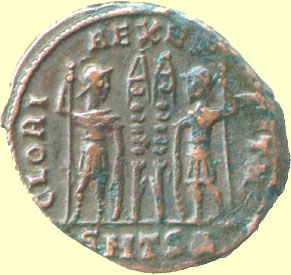
During the late Third, Fourth and Fifth Centuries, many coins began to have a short group of letters placed under the exergue on the reverse giving the city and officina of the mint. In the West, these letters came either before or after the letters denoting the city. The letters were the first letter of the Latin words Primo, Secundo, Tertio, and Quarto, meaning first, second, third, and fourth. In the Eastern cities whose imhabitants' native language was Greek, the Greek letters Alpha, Beta, Gamma, and Delta were used for officina letters. Some common mintmarks and the city they signify are given in the table below.
TRP
Trier, Officina P = Primo = 1
TRS
Trier, Officina S = Secundo = 2
SMTSA
Thessaloniki mint, A = Alpha or first officina, SM = Sacra Moneta
Virtual Galleries
Two Soldiers, two Standards Types of Constantine and His Sons
Related Articles in Other Topic Areas
Return to Fourth Century Roman Bronze Table of Contents
Return to Roman Coins Table of Contents - Up one level.
Return to History and Technology Back Pages - The home page for this entire site.
Identifying Common Fourth Century Roman Bronze Coins
A Picture Gallery of Fourth Century Reverse Types
Camp Gate
Altar Inscribed VOTIS XX
Two Soldiers Standing With Two Standards
Two Soldiers Holding One Standard
Wreath With Legend Inside
Soldier Spearing a Fallen Horseman
VRBS ROMA Commemorative - Mother Wolf Suckling Twins Romulus and Remus
CONSTANTINOPOLIS Commemorative - Victory Standing on Prow of Ship
Two Victories Each Holding a Small Wreath
Emperor Holding Labarum or Standard and Dragging Captive
Victory Advancing Left
A Key to Fourth Century Inscriptions
Some Scarcer Late Fourth Century and early Fifth Century Types